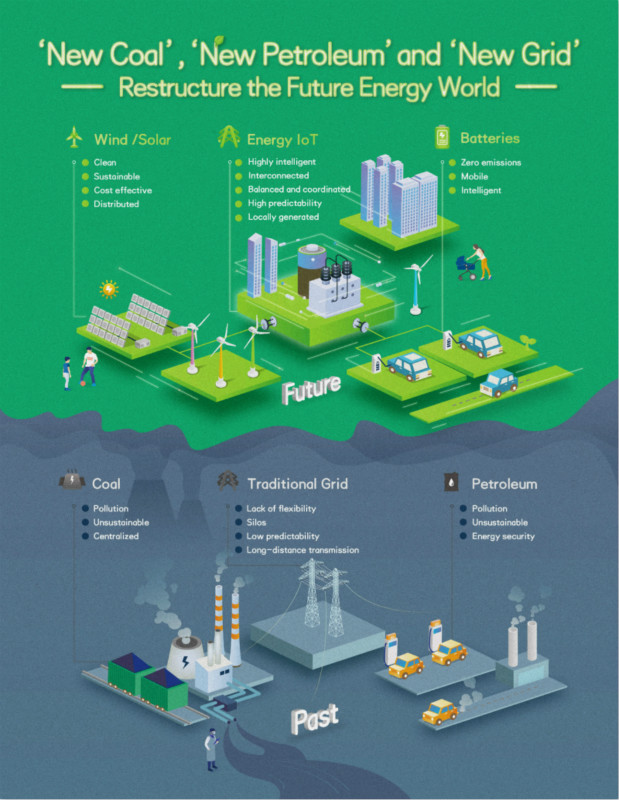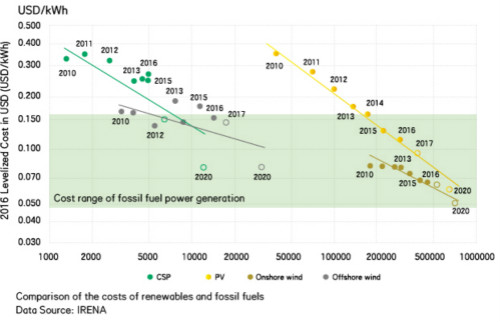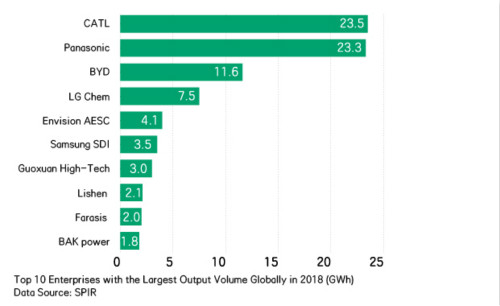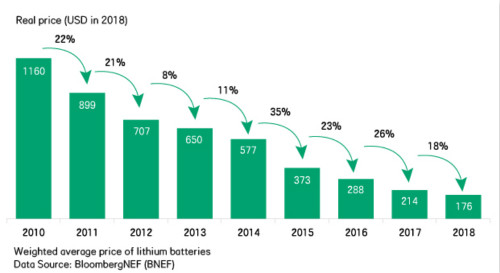'New Coal', 'New Petroleum' and 'New Grid' Restructure the Future Energy World
 |
Driven by technology and innovation, the “new coal” as represented by wind power and PV (Photovoltaic), the “new petroleum” as represented by batteries, and the “new grid” as represented by Energy IoT are contributing to an energy revolution in energy production, consumption and connection that has never been seen before. To take advantage of the biggest energy revolution since the invention of electricity is to seize a tremendous opportunity for developing countries to achieve great-leap-forward development and for energy enterprises to secure major breakthroughs.
Renewable energy is becoming the “new coal” in the sector of energy production
In April 2019, the International Renewable Energy Agency (IRENA) released Global Energy Transformation: A Roadmap to 2050, which says that the share of electricity in total energy use will increase to almost 50% by 2050 and power consumption will have a more than double growth. Renewables will then make up 86% of power generation.
As renewables are promoted by govornments around the world , the levelized costs of energy (LCOE) of wind power and PV have been reduced significantly, even lower than that of fossil fuels. In particular, wind power has the lowest LCOE among renewable energy. According to a report by Lazard, an international research institute, the LCOE of global wind power is lower than 4.5 U.S. cents per kilowatt-hour (kWh) on the basis of levelized cost of electricity. This figure is much lower than that of fossil fuels, nature gas, nuclear power and solar. Therefore, wind power, seen as the “new coal”, is highly competitive in terms of LCOE, which will become a dominant player in new global energy investment.
 |
China’s National Energy Administration (NEA) newly released a list of the first batch of PV and wind power grid-parity projects totaling 20 gigawatts (GW). It signals that new energy generation led by wind power and PV is moving toward the post-subsidy era, highlighting the need to find solutions to sustained LCOE cuts of wind power.
[15%--Leverage the AIoT technology to boost the generation efficiency of wind turbines by 15%]
Envision is the first in the industry to develop "smart turbine" with its exclusive core technology of smart control, advanced measurement method, expert data analysis system, active performance control and reliability-based deterministic turbines. This ensures that the turbine will always function at its optimal working condition for maximum power generation and longer service life. Through a “software-defined turbine” approach, Envision has surpassed the technological limits of traditional wind turbines, and increased the efficiency of wind power generation by 15%. Over the past decade, Envision has been leading the technological progress in China’s wind power industry. From low-speed wind turbines to smart wind turbines to smart wind farms to flexible towers to distributed wind turbines, Envision has ccessfully reduced the cost of wind power and achieved a sustained drop of its LCOE with innovative endeavours.
The realization of grid-parity reassures Envision’s determination to cut the LCOE of wind power with technological innovation. In the future, Envision will roll out smart wind turbines with higher reliability and greater generation efficiency, as well as optimal LCOE solutions to developers by virtue of continuous technological innovation, following the principle of creating more value for clients with technological innovation.
China has become one of the world’s largest renewable energy markets and full-industrial-chain manufacturing bases, as it forges ahead with technological innovation. According to the 2018 China Wind Power Installed Capacity Statistics by the Chinese Wind Energy Association (CWEA), the new installed capacity of China’s wind power market reached 21.14 GW in 2018, 20% of which was contributed by Envision.
Energy storage technology led by EV batteries is fostering the “new petroleum” in the sector of energy consumption.
While the energy transition is taking place in energy production, energy consumption is undergoing a new round of changes as well.
Statistics show that more than 2 million electric vehicles (EV) were sold globally in 2018, accounting for 2.1% of the global auto markets, and more than 60% of these sales were generated by China. The BP Statistical Review of World Energy (2018) estimates that, by 2040, the umber of global EVs will increase to 350 million units, representing 15% of the global vehicle population.
 |
The rapid growth of EVs sales has not only generated tremendous demand for power batteries, but also contributed to a progress in power battery technology and expanding the manufacturing scale, along with ongoing cost cuts in power batteries. Over the past 10 years, the cost of EV power batteries has fallen from $1,000 per kWh to $200 per kWh.
Given that the cost of power batteries accounts for approximately half of that of EVs, the falling price of these batteries has triggered cost cuts for EVs, enabling the latter to better compete against gasoline/diesel vehicles. In the future, power batteries are going to become the “new petroleum” in place of gasoline/diesel as the energy source for vehicles.
In 2018, Envision Group acquired a controlling stake in Automotive Energy Supply Corporation ("AESC"), the electric battery operations and production facilities of Nissan Motor Co., Ltd. ("Nissan"). to pursue further growth in the sector of power batteries.
 |
[USD 50—By 2025, battery costs will be cut down to USD 50 per kWh]
Zhang Lei, CEO of Envision Group said that Envision AESC will cut its power battery production cost to as low as $100 per kWh by 2020 and $50 per kWh five years later.
 |
Emerging technologies as represented by Energy IoT are redefining the “new grid”
Although the rapid growth of renewables like wind power and PV has effectively driven energy transition, their attributes — intermittency, fragmentation and instability — have posed grave challenges to the stability of energy systems. In the meantime, when billions of distributed energy systems comprised of wind turbines, PV panels, energy storage batteries, EVs, smart electric devices and home energy management systems are connected to power grids in the future, the cost of energy system coordination will inevitably emerge.
The advantages of the digital era renders strong technical support to address the cost concerns of energy system coordination, from IoT to cloud computing to AI to real-time control. The fragmented energy world needs to be reunited in the digital era. Such reunion and restructuring will be achieved through.
The State Grid has come to realize the importance of Energy IoT. It casts eyes on the building of a ubiquitous Internet of Energy (IoT)this year that expands innovative space for the combination of renewables and IoE, enables the establishment of virtual power plans based on coordinated distributed power generation through increasingly intelligent information technology and renders digital electricity trading a possibility. At the same time, the development of distributed renewables offers the largest application scenarios to 5G, big data, cloud computing, AI and cyber security among other technologies, thus pioneering the mainstream trends of the industrial Internet.
Envision has realized in a very early period that Energy IoT will become the operating rule of the renewable energy era. Zhang Lei, CEO of the Envision Group, noted that IoE could provide an operating mechanism for the development and production, application and trading, and conversion and storage of distributed energy; it would help coordinate energy systems and production systems to further enhance their efficiency of energy use. He also pointed that it will become indispensable in the flexible interaction between backbone grids and micro grids in the future.
[100 GW—EnOS™ AIoT operating system brings in global energy assets exceeding 100 GW with 60 million sensors and intelligent devices]
Up to now, Envision’s leading AIoT operating system EnOS™ has enabled 60 million devices for wind power, PV and energy storage, charging piles and EVs to achieve real-time intelligent coordination, facilitated large-scale renewables access and accelerated energy transition.
Benefited from the technologies of big data and IoT, and Envision’s know-how in the energy sector, EnOS™ effectively boosts the efficiency of energy use, alters the characteristics of grids, regulates grid frequency and demand, reduces future investments in grids and thus incorporates renewables into grids more effectively.
The largest European residential energy storage company Sonnen is a client of Envision’s EnOS™. The company provides automatic optimization of intelligent energy storage terminals to every family based on changes in the weather, the grid power flow and family activities. Through Envision’s EnOS™, every Sonnen-produced energy storage battery could be connected with neighbors’ and neighborhood’s solar cells, EV batteries and energy-consuming devices, thus giving rise to energy sharing communities.
In Singapore, EnOS™ helps the government accelerate the development of next generation IoT-based solutions in their digitalisation goals. The Government Technology Agency is using EnOS™ to develop an in-house device management and data acquisition system. Singapore’s Keppel Urban Solutions, a wholly owned subsidiary of Keppel Corporation, has also developed its Smart City Operating System based on the EnOS™ suite.
The rapid development of the three major industries — wind power, batteries and Energy IoT— rides on the mainstream trends of energy transition, and, in the meantime, the internal logic of their development will be joined by the implementation practice to play a role in the trends. As Zhang Lei pointed out, “Wind power is the new coal mainly focused on the production side and essentially driven by technology, as it seeks to cut LCOE through advanced technology; batteries are the new petroleum, playing a more important role in the consumption of EVs; AIoT is the new grid whose nature resides in connection and balancing. When renewables become the new coal and batteries the new petroleum, energy systems will become fragmented and random. To achieve wider and smarter connection and balancing, it should resort to IoT and AI.”
Envision has been practicing its mission of solving the challenges for a sustainable future since its establishment. The layout of “the new coal”, “the new petroleum” and “the new grid” opens up an opportunity for Envision to lead the global smart energy revolution and create a beautiful energy world through technological innovation.
For more information, please visit Envision’s website: http://www.envision-group.com
Disclaimer:
Sponsored content: The views expressed in the post are those of the author.


